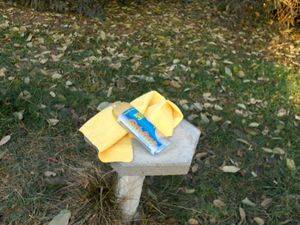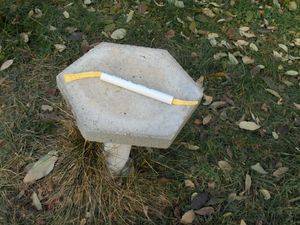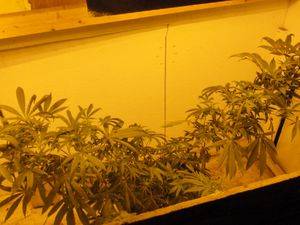G
Guest
High friends and fellow growers
Ive gotten so many good ideas from IC members, so I wanted to present this device with the hope that it will spark an idea or provide some insight and relief into the issue. Feel free to use and adapt this at your pleasure.
After suffering extreme drought for 2 staight years and loosing 2/3 of my crop, I collaborated with a couple of other local outsiders to find a solution to our watering problems..
We had all concluded that hand watering at the surface isnt effective unless the amount poured on is considerable. Smaller amounts of water poured on bone dry ground doesnt penetrate and has no real value or effectiveness. Two gallons of water, poured on very dry ground at the surface of the plant, penetrates to a depth of 1 1/4 " after 2 hrs. Observations indicate that cannabis roots began to appear at a depth of 3/4". Sixty percentof the water poured on the surface around a plant is absorbed by the soil above root level, soil off to the side that doesnt contain cannabis roots or, the moisture evaporates off and never becomes available to the plant.
The amount of water reaching the plant using this watering method provides enough moisture to keep the plant from wilting and does allow for some vegatatve growth but is not enough for the plant to mature properly. The buds will always be whispy and thin, even if the plant is a branch breaker. We found the condition to be irreversable and once a plant had experienced several wilting periods, regaurdless of how much water was provided after the repeated wilting events, the plants wouldn't finish properly. The hopeful grower under this scenario continues to work and water plants that are never going to mature properly. Ive been there. We observed this failure to mature properly after extended periods of wilt in 11 different strains.
-Nute absorbtion and fertilization are interrupted and problematic where there is no rain to wash ferts in or assimilate them into the grow spot soil. They tend to concentrate and salt up around the plant in the location they're poured out in and then if rain comes, its like a bunch of fertilizer gets released all at once. An alternate feeding approach is needed during long dry spells.
Our agreed solution: To be effective in this enviroment, the water and nutes have to be deliverd directly to the root sytem where it is needed and can be utilized by the plant just as it is with hydro and drip feeds. This basic premise drove our efforts.
After staring at the cats watering bowl and watching the TV ads for "Aqua globes", we developed and tested the following system device we call the " gorilla collar".
The device cost $1. 48 each to construct and can be built at a rate of 15 collars per hour. The 40 i needed cost me around $60 and took me about 4 hrs to complete them with a smoke break or 2 in the mix. A miniscule cost considering that I lost 15lbs of smoke and unknown gallons of gasoline and wasted labor trying to pack water.. It takes approximately 10 minutes extra at planting time to set the collar but watering efforts are reduced by 2/3 if not more.I would contend that this 10 minutes will save the grower 10 hrs of watering time over the course of the season. Once produced, the collars should last forever.
The collar:
It delivers water and when included, nutes directly and immediately to the root system and holds it there for the plants availablity. This approach solved the problem of absorbtion of the moisture by soil which contained no roots and of the problem of evaporation. It was the testing of this device that revealed the amount of water lost by pouring it on the surface. The collar had 4 obvious and repeatable impacts.
1. It reduced the amount of moisture one must carry to the plant dramatically. Two litres of water using the collar supplied the plants need for 3 full days under extremely dry conditions. Surface watering amounts for the same plant would have been 6 gallons - 2 gals. per day. On one plant were a 5 gallon satellite reservoir was used, the 5 gallons of water fed the plant continuously for over 3 weeks.
2. Because of the capacity of the device to hold water nthe root area, the tendency of plants to wilt between waterings is eliminated and the unreversable damage
to the plants flowering procees is eliminated.
3.The amount of ferts needed is reduced by more than half and what is supplied is immediately available to the plant roots. The effects of nutrient applications using the collar can be seen within 4 hrs of application where deficiencies exist.. It also allows for slow, continuous feeding when desired.
4. Unlike surface water that needs to be applied in the evening or early morning so that the water can soak in before evaporation, plants with the collar can be watered anytime without the problems of evaporation..
The collar installed, buried to the neck and loaded with a solution of nutes:
Burying the collar 3" or so, places the tubes in the soil to release their water at root level.
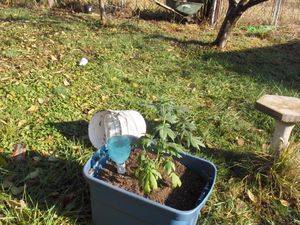
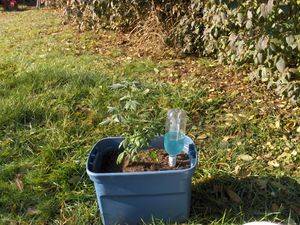
The collar before intallation:
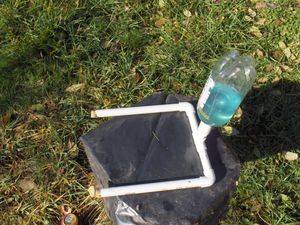
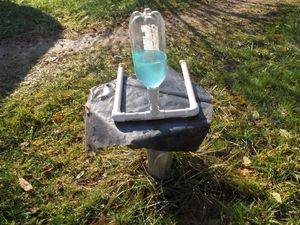
The single pronged collar we tested with a reservoir system. The line from the reservoir was simply inserted in the neck instead of a 2 litre bottle.
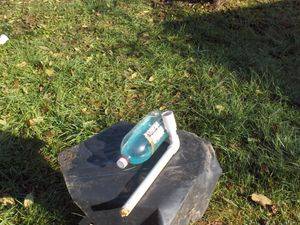
Demonstration of a reservoir water line installation instead of the 2litre bottle


The parts list:
The parts are very simple and cheap. Pvc pipe, 3/4 or 1", whatever your preferance. 2 90 degree elbows, 1 Tee, 1 1" adapter as a mouth, and 2 shop towels, newspaper or other absorbant material and unless you want to use something different, a cellulose sponge. Parts for the single prong feeder are simply a piece of platic pipe and one 90 degree elbow and the end of the tube stopped up with sponge.

Holes must be drilled in the bottom side of the pvc so that the water will leach from the water supply, through the tubes and out the holes into the area of the plants roots. The purpose of the paper towels is to prevent mud from filling the leaching holes and to distribute moisture evenly around the pvc tubing. The roots grow right up to this material. The only qualification is that it be absorbant and unoffensive to plant roots.
Ive used pieces of sponge to fill the end of my tubes and I discovered the plant roots grew right into the end of the tubes and into the sponge. This factor should be explored further as one could entice the roots to attach to the tubes using the right material
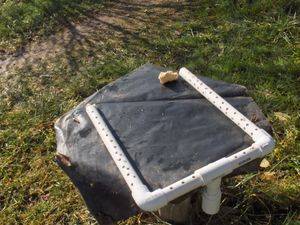
Here are the towels encircling the tubing.
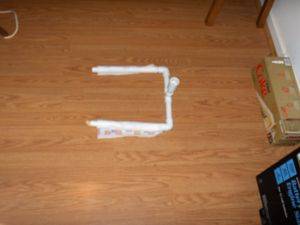
We didn't take pictures of the original test simply because we thought it was just a trial and we wouldnt take photos until we had created the final product. The device worked so well that we have done nothing to the basic design, but have created numberous adaptations, including the dumping of the end of the tubing into a platic cup drillled with holes and filled with gravel and sponge pieces which creates a situation where the plant roots grow into and fill the rock/sponge filled cup just as the would deveop in a bubbler system. Theoretically, this design would allow a growe to grow in a location where the soil was very poor.
I have more pics and infor I will post if others are interested. This simple device dramatically changes the watering scenario by increasing water efficiency by 300% or more. For every 100 gallons of water delivered to the plant - this device reduced that amount for us to approximately 30 gallons.
My aching back.
I apologize about the thumbnails, I cant seem to get them out.
Ill be back.
Ive gotten so many good ideas from IC members, so I wanted to present this device with the hope that it will spark an idea or provide some insight and relief into the issue. Feel free to use and adapt this at your pleasure.
After suffering extreme drought for 2 staight years and loosing 2/3 of my crop, I collaborated with a couple of other local outsiders to find a solution to our watering problems..
We had all concluded that hand watering at the surface isnt effective unless the amount poured on is considerable. Smaller amounts of water poured on bone dry ground doesnt penetrate and has no real value or effectiveness. Two gallons of water, poured on very dry ground at the surface of the plant, penetrates to a depth of 1 1/4 " after 2 hrs. Observations indicate that cannabis roots began to appear at a depth of 3/4". Sixty percentof the water poured on the surface around a plant is absorbed by the soil above root level, soil off to the side that doesnt contain cannabis roots or, the moisture evaporates off and never becomes available to the plant.
The amount of water reaching the plant using this watering method provides enough moisture to keep the plant from wilting and does allow for some vegatatve growth but is not enough for the plant to mature properly. The buds will always be whispy and thin, even if the plant is a branch breaker. We found the condition to be irreversable and once a plant had experienced several wilting periods, regaurdless of how much water was provided after the repeated wilting events, the plants wouldn't finish properly. The hopeful grower under this scenario continues to work and water plants that are never going to mature properly. Ive been there. We observed this failure to mature properly after extended periods of wilt in 11 different strains.
-Nute absorbtion and fertilization are interrupted and problematic where there is no rain to wash ferts in or assimilate them into the grow spot soil. They tend to concentrate and salt up around the plant in the location they're poured out in and then if rain comes, its like a bunch of fertilizer gets released all at once. An alternate feeding approach is needed during long dry spells.
Our agreed solution: To be effective in this enviroment, the water and nutes have to be deliverd directly to the root sytem where it is needed and can be utilized by the plant just as it is with hydro and drip feeds. This basic premise drove our efforts.
After staring at the cats watering bowl and watching the TV ads for "Aqua globes", we developed and tested the following system device we call the " gorilla collar".
The device cost $1. 48 each to construct and can be built at a rate of 15 collars per hour. The 40 i needed cost me around $60 and took me about 4 hrs to complete them with a smoke break or 2 in the mix. A miniscule cost considering that I lost 15lbs of smoke and unknown gallons of gasoline and wasted labor trying to pack water.. It takes approximately 10 minutes extra at planting time to set the collar but watering efforts are reduced by 2/3 if not more.I would contend that this 10 minutes will save the grower 10 hrs of watering time over the course of the season. Once produced, the collars should last forever.
The collar:
It delivers water and when included, nutes directly and immediately to the root system and holds it there for the plants availablity. This approach solved the problem of absorbtion of the moisture by soil which contained no roots and of the problem of evaporation. It was the testing of this device that revealed the amount of water lost by pouring it on the surface. The collar had 4 obvious and repeatable impacts.
1. It reduced the amount of moisture one must carry to the plant dramatically. Two litres of water using the collar supplied the plants need for 3 full days under extremely dry conditions. Surface watering amounts for the same plant would have been 6 gallons - 2 gals. per day. On one plant were a 5 gallon satellite reservoir was used, the 5 gallons of water fed the plant continuously for over 3 weeks.
2. Because of the capacity of the device to hold water nthe root area, the tendency of plants to wilt between waterings is eliminated and the unreversable damage
to the plants flowering procees is eliminated.
3.The amount of ferts needed is reduced by more than half and what is supplied is immediately available to the plant roots. The effects of nutrient applications using the collar can be seen within 4 hrs of application where deficiencies exist.. It also allows for slow, continuous feeding when desired.
4. Unlike surface water that needs to be applied in the evening or early morning so that the water can soak in before evaporation, plants with the collar can be watered anytime without the problems of evaporation..
The collar installed, buried to the neck and loaded with a solution of nutes:
Burying the collar 3" or so, places the tubes in the soil to release their water at root level.


The collar before intallation:


The single pronged collar we tested with a reservoir system. The line from the reservoir was simply inserted in the neck instead of a 2 litre bottle.

Demonstration of a reservoir water line installation instead of the 2litre bottle


The parts list:
The parts are very simple and cheap. Pvc pipe, 3/4 or 1", whatever your preferance. 2 90 degree elbows, 1 Tee, 1 1" adapter as a mouth, and 2 shop towels, newspaper or other absorbant material and unless you want to use something different, a cellulose sponge. Parts for the single prong feeder are simply a piece of platic pipe and one 90 degree elbow and the end of the tube stopped up with sponge.

Holes must be drilled in the bottom side of the pvc so that the water will leach from the water supply, through the tubes and out the holes into the area of the plants roots. The purpose of the paper towels is to prevent mud from filling the leaching holes and to distribute moisture evenly around the pvc tubing. The roots grow right up to this material. The only qualification is that it be absorbant and unoffensive to plant roots.
Ive used pieces of sponge to fill the end of my tubes and I discovered the plant roots grew right into the end of the tubes and into the sponge. This factor should be explored further as one could entice the roots to attach to the tubes using the right material

Here are the towels encircling the tubing.

We didn't take pictures of the original test simply because we thought it was just a trial and we wouldnt take photos until we had created the final product. The device worked so well that we have done nothing to the basic design, but have created numberous adaptations, including the dumping of the end of the tubing into a platic cup drillled with holes and filled with gravel and sponge pieces which creates a situation where the plant roots grow into and fill the rock/sponge filled cup just as the would deveop in a bubbler system. Theoretically, this design would allow a growe to grow in a location where the soil was very poor.
I have more pics and infor I will post if others are interested. This simple device dramatically changes the watering scenario by increasing water efficiency by 300% or more. For every 100 gallons of water delivered to the plant - this device reduced that amount for us to approximately 30 gallons.
My aching back.
I apologize about the thumbnails, I cant seem to get them out.
Ill be back.
Last edited:


